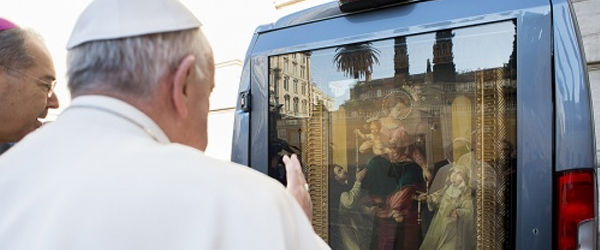The 16th century Italian saint was a member of the illustrious House of Gonzaga and as the oldest son was due to inherit great wealth and prestige. However, from a young age he devoted himself to prayer and at 17 gave up all rights of inheritance to enter the Jesuit novitiate in Rome. Despite frail health, he continued in his studies.Five years later he had a vision that he would die within the year. The plague in Rome broke out soon after and Aloysius volunteered to work in a ward where he became infected. He died at age 23 in 1591, already known for his purity and prayer life. Pope Benedict XIII canonized him in 1726 and Pope Pius XI named him the patron of Christian youth. When Bishop Thomas Conaty named this parish in 1908 (one of five opened that year), there were about 100,000 Catholics in the Diocese of Monterey-Los Angeles and just 15 parishes in the city of Los Angeles. (The year 1908 was remarkable for several other milestones: it heralded the first Model T auto, the first celebration of Mother’s Day, and the appointment of The Tidings’ first and only woman editor — Alice Stevens.)In Los Angeles St. Aloysius Gonzaga parish opened in November, and Father P. J. McGrath, the founding pastor, celebrated Mass in a bungalow on Crockett Boulevard. A small church was built shortly after and then remodeled in 1922. The Sisters of Mercy staffed the new school of 160 students while commuting from St. John’s Military Academy in Anaheim until 1926 when a convent was completed. Until 1932, records remain of only one pastor out of eight, Father John Prendiville, from Ireland, who served from 1913 to 1915 and later was a chaplain in San Pedro and Burbank. Msgr. Daniel Hurley, of County Cork, who had served as pastor for four years at Nativity in Torrance, headed St. Aloysius from 1932 to 1939. He then served 15 years at San Buenaventura Mission and 18 years at Our Lady of the Assumption in Ventura; he died in 1982 at age 88. During his 11 years as pastor, Father William O’Regan, from County Limerick, built a new parish school for 600 students (in 1950), staffed by the Sisters of Mercy who continued teaching there for many years. Father O’Regan also had plans for a modern church and convent but he died suddenly of a heart attack on Thanksgiving Day 1950. At his funeral Bishop Joseph McGucken spoke of him as a “humble, kindly priest who gave his full love and services to his people.”The pastorate of Father John Stapleton (1951-58) saw Auxiliary Bishop Timothy Manning bless the new combination church-school in November of 1951. The area was dubbed the “island” parish as it was surrounded by the City of Los Angeles; parishioners called themselves “islanders” with L.A. on three sides and Huntington Park on the other.Another Irishman from County Tipperary, Father James Flanagan, headed the parish for four years and died the last year of his pastorate in 1962 at age 52. For short pastoral terms, three other priests served the parish but the longest period was that of Father Jose Bellavista. Born in Spain he was ordained in 1936 in Barcelona shortly before the Spanish Civil War broke out (eight of his fellow ordinands and the bishop were murdered). Father Bellavista escaped, served as a military chaplain and in 1950 came to Los Angeles. He served in several parishes, and at St. Aloysius was the associate for nine years and pastor from 1973 to 1982. He died at age 89 in 2000.From 1982 to the present, four priests have served as either administrators or pastors — Fathers Robert Pizzorno, George Aguilera, Ramon Palomera and the current administrator, Father Pedro Esteban, from Spain, who was previously pastor at Epiphany Church in South El Monte. He is continuing the parish’s century of service and devotion, in the spirit of its Jesuit patron who served with such piety.{gallery width=100 height=100}gallery/2011/0812/aloysiusside/{/gallery}

